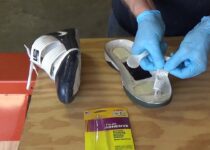Liquid Nails vs Wood Glue
Sometimes choosing the right product for your project is easy. Other times it may take some research. You must research the pros and cons of liquid and wood glue before deciding which suits your needs.
Both liquid nails and wood glue are great for bonding two surfaces. You can use both on surfaces other than wood. However, liquid nails will create a stronger bond. Wood glue is safer and easier to use than its industrial-strength counterpart.
Both of these products have their benefits depending on what type of project you use them. Some DIY project enthusiasts might argue that liquid nails and wood glue are interchangeable. However, pros will tell you that they serve a different purpose and have unique features. We have compiled a list of pros & cons for liquid nails and wood glue to help you decide. Let’s take an in-depth look.
What Is Liquid Nail?
It is a construction adhesive with amazing bonding strength, especially on non-porous surfaces. You can use it on many materials, including wood, metal brick, glass, fabric, and vinyl. This makes it versatile.
It is used primarily in construction because it is an adhesive ideal for heavy-duty work such as tile repairs, crown molding, backsplashes, and hanging pictures on the wall.
When working with non-porous surfaces like varnished or painted wooden wood, Liquid Nails work better than wood glue. Because it bonds faster, it is a better option for materials that are difficult to clamp.
Liquid nails are a favorite of craftsmen due to their strength. It is strong, and you can paint it to create a neat work surface. Liquid nails might not be the best choice for delicate tasks or arts and crafts.

Advantages
- Easy to use and holds well.
- They also dry quickly
- Adapts colors to temperature fluctuations
- Paintable on more than one surface
Disadvantages
- It can be difficult to remove them once they are applied.
- Misuse of this product can cause damage to surfaces
What Is Wood Glue?
Wood glue doesn’t really need much explanation. The key is the name itself. It refers to a product that can bond two pieces of wood together. Wood glue is an old-fashioned product that modern technology cannot replace. Wood glue is strong but can be mixed quickly and applied quickly.
You can trace the earliest known types of wood glue back to 2000 BC. These were made with animal products, including collagen from boiling hides, and have exceptional adhesive properties.
Wood glue is excellent for repairing furniture and damaged home parts, including chairs. Wood glue won’t hold up as well as epoxy-type glue, but it is still effective. You can use it to fix wall holes or attach the bottom to a damaged shelf.

Advantages
- Wood glue can be used as an adhesive on many surfaces, including wood, metal, and plastic.
- Wood glue dries fast and is applied within 15 minutes. Wood glue takes approximately 24 hours to dry.
- Wood glue can create strong bonds between many surfaces, not just wood.
Disadvantages
- For large-scale projects, wood glue might require a larger amount.
- The strength of faster-drying wood glue won’t be as strong as that of liquid nails, which take longer to dry and cure.
- Sometimes evenly distributed pressure is required to create a strong bond between pieces to which the glue is applied.
Wood Glue vs Liquid Nails – An Ultimate Comparison Guide

Let’s take a closer look at their comparison:
-
Life
Liquid nails are extremely durable. This makes liquid nails a popular choice for construction because it guarantees that your project won’t crumble all at once.
Like liquid nails, wood glue can also last a long time and won’t come off your project once applied. You can use wood glue for paraphernalia, which is usually outdoors. It will not get ruined by rain as wood glue is water-resistant.
Comparing the two can show that liquid nails are more durable than wood glue.
-
Strength
Although wood glue has some strength, it’s not strong enough to support much weight. But liquid nails, a strong construction adhesive with a lot of impact resistance, can be used to support a lot of weight. However, it is the stronger option, but at a higher price.
-
Application
Wood glue is typically cheaper than liquid nails but is also weaker- and less resistant.
Wood glue is excellent for bonding two pieces of wood together. Regular PVA wood glue can’t withstand water or damage. We do not recommend regular wood glue for outdoor bonding. It is also not resistant to heat or solvents. It can be easily melted or dissolved by solvents and high temperatures.
Liquid nails provide a stronger, more durable bond that is waterproof, heat-resistant, solvent-resistant, and impact-resistant. Liquid nails can bond to more materials than regular PVA wood glue.
Know more about glues that work on abs and pvc type of material easily in this article if you are interested to glue them easily for superior bond quality.
-
Dry Period
When you want strong adhesive bonds, you must consider the time for the glue to dry. Wood glue is an excellent choice if you need a strong bond between two items in 15-20 minutes.
Apply wood glue to the material. Hold the pieces together for about a minute, then apply pressure to allow the pieces to bond.
On the other hand, liquid nails may take longer for the glue to dry completely. After applying glue, you should hold the pieces together for at least 15 minutes. It may take up to 24 hours for the glue to dry completely.
-
Fumes
Wood glue is similar to ordinary school glue. However, it doesn’t have strong or harsh odors. Wood glue can even be safe for food-based applications.
However, liquid nails can emit toxic fumes and may require ventilation. It contains solvent-based, flammable, potentially toxic ingredients, especially when wet. Liquid nails are safe once dried.
Which one do you prefer for your projects?
Wood glue is composed of an adhesive and filler. The glue holds the pieces together, while the filler helps the glue stick more securely.
Many types of adhesives are available, so choose one compatible with your project.
Liquid Nails, a type of adhesive that sticks things together with a liquid adhesive, is trendy. It is easy to use and does not require any preparation.
Liquid Nails are non-toxic and therefore environmentally friendly. They are an excellent option because of the many uses they have. Liquid nails are also affordable.
Both adhesives have pros and cons. It all depends on what you’re looking for in an adhesive.
Conclusion
Liquid Nails are better if you’re looking for greater versatility and stronger connections between non-porous materials.
Wood glue may be better if you need to join only two pieces of untreated wood. For your home DIY woodworking project, wood glue will be your best option.
Because of the many uses of adhesives, it is a good idea to keep both types of adhesives close to you in case of an emergency.
Frequently Asked Questions
Are Liquid Nails more powerful than wood glue?
Yes, liquid nails can create stronger bonds than traditional wood glues. A construction adhesive is best to bond things with maximum strength.
What can you bond with liquid nails?
Liquid nails can bond metal, treated timber, and other non-porous materials.
Is wood glue strong enough for the wood to bond?
Wood glue can hold the wood together after it has thoroughly dried.
Are liquid nails waterproof?
Most liquid nails are waterproof, but it is best to verify with the manufacturer.

Being associated with art and craft field since decades as a hobbyist and life long learner has given me an opportunity to learn many new things related to art, craft, paints and pottery which i am trying to share with your guys on this website. I have expertise of being professional painter and potter for the last 20+ years
I have learned mind blowing cool tips and insights which makes me a person with ability to improvise and come up with creative ideas and solutions to make stunning and impeccable art pieces of all types which are adored by people across the globe on this website and other platform.


